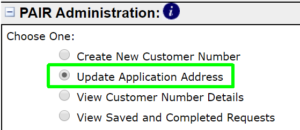
The “Update Application Address” function is an important part of Private PAIR. The corresponding function is missing from Patentcenter. This is feature request FR19.

Bluesky: @oppedahl.com

The “Update Application Address” function is an important part of Private PAIR. The corresponding function is missing from Patentcenter. This is feature request FR19.
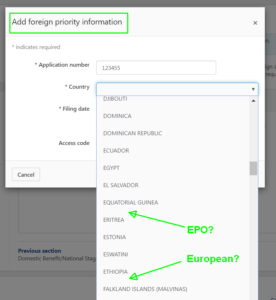
Six months have now passed since I first reported this problem to the EBC. Still it has not been fixed. EPO is missing from the Web-based ADS function in Patentcenter!
EPO is in the web-based ADS function in EFS-Web. But it is missing in the corresponding function in Patentcenter. This is bug report CP9 and you can read about it here.
This would be so very easy to fix. It would be a matter of adding one line of text in a list item on a web page.
Without comment or explanation, the developers of Patentcenter have removed the Corrected ADS function from Patentcenter. In this April 30 blog article I reported that it was buggy. This became bug report CP4. Now it’s gone from Patentcenter.

When Patentcenter launched in alpha test in September of 2018, one of the first things that the alpha testers pointed out was that an important feature from EFS-Web was missing — the last 40 acknowledgment receipts. Continue reading “Imminent: last 40 ack receipts in Patentcenter”
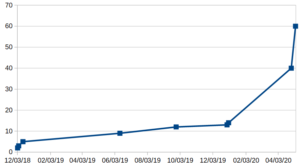
US national phase entries in Patentcenter are assigned from a block of application numbers starting at 15/733,001. Our firm was the third ever to file a 371 case in Patentcenter, receiving application number 15/733,003.
By the end of 2019, there had been fifteen 371 cases filed. My firm had filed seven of those cases. Yes my firm had done about half of all of the US national-phase work in Patentcenter from the beginnings of alpha test until the end of 2019.
By now, with Patentcenter opening up for general use, there has been an uptick in national-phase filings in Patentcenter. Twenty of them have been filed just in the past eight days.
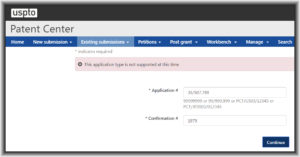
(This is Patentcenter trouble ticket number CP22.)
(This has still not been fixed as of June 10. I phoned the EBC to open another trouble ticket. The new ticket number is 1-696205867.)
I was quite surprised today to be reminded that a defect in Patentcenter that I had reported to the USPTO back in December of 2019 has still not been corrected. The defect is that it is impossible, in Patentcenter, to e-file any follow-on submission in any 35-series design patent application. You can see this in the screen shot at right. Continue reading “Patentcenter is broken for Hague cases”
(Note: This is Feature Request FR9.)
(Update: I watered down the “ask” as you can see at the end of the blog post.)
Everybody in every intellectual property office provides permalinks. Everybody except the PAIR developers at USPTO, that is. This is USPTO’s chance to be in harmony with everybody else and provide permalinks in Patentcenter, as I will explain. Continue reading “Patentcenter feature request: permalinks”

Private PAIR has a feature in “Search by Customer Number” called “Applications with Status Changes”. You can see it quoted at right. The feature is extremely helpful. Every night, shortly past midnight, I use this feature to check for cases in my firm’s portfolio that have had recent status changes. It helps us serve our clients better.
And Patentcenter lacks this feature. I reported this need to the USPTO back in September of 2018 (see article).
You can sort of fumble around in Patentcenter and try to find similar information. You can go into your “workbench” and sort on “status date”. And then you can click on an application of interest, and look around it in that application to see what the status change is about, report it to the client and so on. But then when you are done, Patentcenter will have lost everything about what you were doing. You will have to go back to your workbench again, and sort on “status date” again, and then try to figure out where in the resulting list you had been, to figure out which case to look at next.
USPTO has said many times that one of its goals is to provide, in Patentcenter, each of the user features that is provided in Private PAIR and in EFS-Web. Part of fulfilling that goal would be to provide this “Applications with Status Changes” feature in Patentcenter, just as in Private PAIR.
This is feature request FR3.
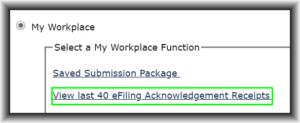
(Update: it looks like this feature is imminent. See blog article.)
EFS-Web has the feature “View last 40 eFiling Acknowledgement Receipts”. Patentcenter needs to have this same feature. I pointed this out to the USPTO in September of 2018 as an alpha tester of Patentcenter.
This is Feature Request FR4.
Please post a comment below.
One of the things that I always do after I have e-filed something in Patentcenter is to go and look in IFW to see just what USPTO received from me. I want to check it to make sure I filed what I meant to file. I want to make sure that the PDF image did not get degraded or converted to a blank page (as occasionally happens). And in most cases I want to download what the USPTO received from me and send it to the client so that the client can see exactly what the USPTO received.
This requires copying an application number and doing multiple mouse clicks, and eventually reaching a screen where I can paste in the application number and then click some more to get to IFW. And only then am I able to see what the USPTO received from me in the e-filing.
So here’s the feature request. On the “success” page where Patentcenter says I have successfully e-filed something, can there please be a “deep link” that goes directly to the IFW screen for the particular patent application in which I just e-filed something?
I could then for example right-click on it and open a new page and I could see what the USPTO received from me.
This is Patentcenter feature request FR2.
Would you find this feature helpful? Please post a comment below.